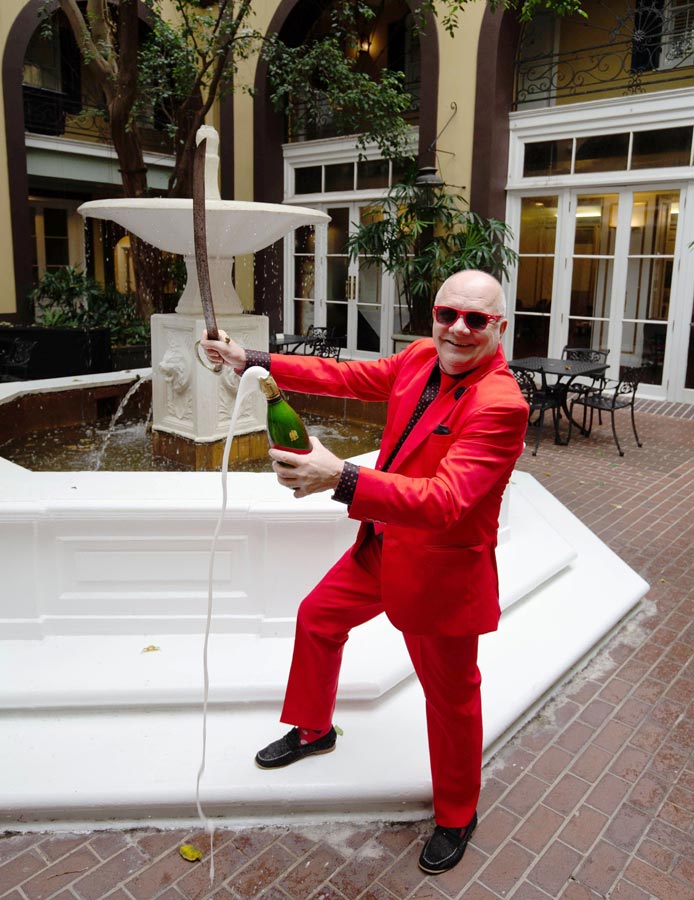November 01, 2019
“In victory, you deserve Champagne; in defeat, you need it.” — Napoleon Bonaparte
You don’t have to be a diminutive French dictator to know that nothing says celebration - or consolation - like champagne. Beyond festive, an elegant glass of bubbles sets the stage for great things to come. When kicking off or celebrating the holiday season, take some advice from wine guru Patrick Van Hoorebeek, of the Patrick’s Bar Vin in the French Quarter, and do it up right.
Opening the bottle
“First, absolutely be sure the champagne is very cold,” he said. “Even if it’s chilled put in in the freezer for a few minutes.” Although he often uses a saber to hit the cork, unwrapping the wire cage and pointing the bottle away from you at 45 degrees while you rotate the cork works fine.
The Glass
Van Hoorebeek generally serves in flutes – “so you can see the bubbles.” But he also has the saucer-shaped glasses at his bar, famously said to be modeled after Louis XV’s mistress’ breasts. “Is it true? Knowing the French people, I say it is true. And it’s just the front of the breast – not the whole thing!”
Champagne vs. sparkling
As most fans know, champagne can only legally be called that if it’s from the Champagne region of France. True champagne is a combination of three grapes: two red, Pinot Noir, and Pinot Meunier and Chardonnay, a white. Each champagne house guards its own particular formula at all costs – “like the gumbo you get at Antoine’s or The Rib Room will always be there own secret recipe,” he said.
You don’t have to break your budget to drink the real thing, said Van Hoorebeek, who founded the wine-themed Krewe of Cork in 2000. “Mum Cordon Rouge, (around $37), Nicolas Feuillatte (in the $35 range) and Piper-Heidsieck ($50-$60) and Taittinger (around $50) are all good values.”
If money is no object, go with Nicolas Feuillatte Palmes d’Or Grand Cuvee ($130 and up) Vintage Krug Brut ($300) and the lesser known but highly prized Salon champagne, which starts in the high $400s.
Although his palate is educated, Van Hoorebeek is no shamer. “I sell both Prosecco and Spanish Cava, both are good.” He recommends sparklers from the Loire Valley – his house pour is Kraemer – which retails at $8. Another well priced French sparkler is Blanquette de Limoux from the Pyrenean foothills in the south of France, a great deal in the $20 range.
Never happier than when he’s sipping and toasting his customers, who he always treats like dear friends, Van Hoorebeek has a simple wish when it comes to champagne. “I wish to live a long and healthy life and have a glass of champagne at 11 am every day. So far, so good!”
You don’t have to be a diminutive French dictator to know that nothing says celebration - or consolation - like champagne. Beyond festive, an elegant glass of bubbles sets the stage for great things to come. When kicking off or celebrating the holiday season, take some advice from wine guru Patrick Van Hoorebeek, of the Patrick’s Bar Vin in the French Quarter, and do it up right.
Opening the bottle
“First, absolutely be sure the champagne is very cold,” he said. “Even if it’s chilled put in in the freezer for a few minutes.” Although he often uses a saber to hit the cork, unwrapping the wire cage and pointing the bottle away from you at 45 degrees while you rotate the cork works fine.
The Glass
Van Hoorebeek generally serves in flutes – “so you can see the bubbles.” But he also has the saucer-shaped glasses at his bar, famously said to be modeled after Louis XV’s mistress’ breasts. “Is it true? Knowing the French people, I say it is true. And it’s just the front of the breast – not the whole thing!”
Champagne vs. sparkling
As most fans know, champagne can only legally be called that if it’s from the Champagne region of France. True champagne is a combination of three grapes: two red, Pinot Noir, and Pinot Meunier and Chardonnay, a white. Each champagne house guards its own particular formula at all costs – “like the gumbo you get at Antoine’s or The Rib Room will always be there own secret recipe,” he said.
You don’t have to break your budget to drink the real thing, said Van Hoorebeek, who founded the wine-themed Krewe of Cork in 2000. “Mum Cordon Rouge, (around $37), Nicolas Feuillatte (in the $35 range) and Piper-Heidsieck ($50-$60) and Taittinger (around $50) are all good values.”
If money is no object, go with Nicolas Feuillatte Palmes d’Or Grand Cuvee ($130 and up) Vintage Krug Brut ($300) and the lesser known but highly prized Salon champagne, which starts in the high $400s.
Although his palate is educated, Van Hoorebeek is no shamer. “I sell both Prosecco and Spanish Cava, both are good.” He recommends sparklers from the Loire Valley – his house pour is Kraemer – which retails at $8. Another well priced French sparkler is Blanquette de Limoux from the Pyrenean foothills in the south of France, a great deal in the $20 range.
Never happier than when he’s sipping and toasting his customers, who he always treats like dear friends, Van Hoorebeek has a simple wish when it comes to champagne. “I wish to live a long and healthy life and have a glass of champagne at 11 am every day. So far, so good!”


